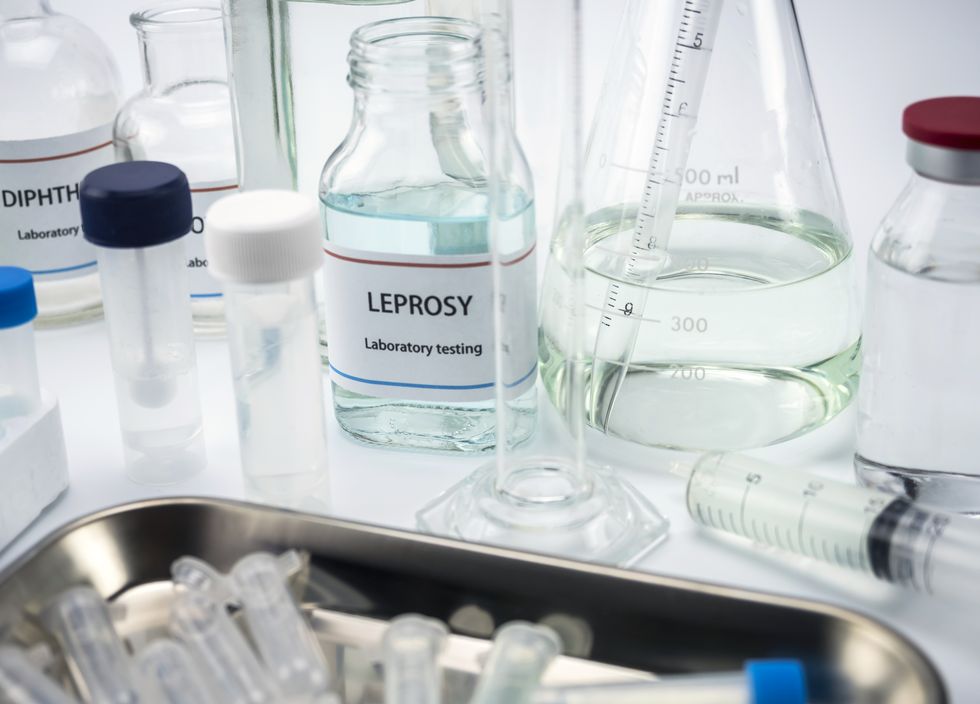LEPROSY MAY SEEM like a disease of the past. But, a new report published in the Centers for Disease Control and Prevention’s journal Emerging Infectious Diseases says cases of leprosy have been increasing in Florida, and the condition may have become endemic in the southeastern U.S.
However, leprosy, an infectious disease that can cause skin lesions and nerve damage, is still rare. Infectious disease experts say you likely don’t need to worry too much about contracting it, but it’s important to be aware of the condition and its signs.
Even with the news of increasing leprosy cases in Florida, “the number is small compared to the global burden of the disease,” says Julie Trivedi, M.D., medical director of infection prevention at the University of Texas Southwestern Medical Center. “Globally, there are thousands of cases diagnosed each year.”
More From Men’s Health

In 2020 (the most recent year of available data), 159 cases of leprosy were reported nationwide, and Central Florida accounted for about 20 percent of them, according to the CDC report. Worldwide, there are about 200,000 new cases a year, according to the World Health Organization.
“Leprosy is classified as a neglected tropical disease, but people should know that it can hit closer to home,” says Mark Cameron, Ph.D., an associate professor and systems biologist at Case Western Reserve University, who’s working to identify biomarkers of infectious diseases via genomic technologies and bioinformatic methods.
“I hope the recently heightened surveillance and awareness regarding what leprosy is, what to watch for if traveling to endemic areas, and how to recognize and seek treatment for the illness will relieve people’s worries,” he adds. The CDC hasn’t issued a travel advisory for Florida or other states because of leprosy.
The good news is that most people actually aren’t at risk of contracting leprosy. But, Dr. Trivedi says, “You should be aware and vigilant.” Here’s a closer look at what leprosy is, how you can get it, and what signs to watch for.
What Is Leprosy?
Also known as Hansen’s disease, leprosy is an infectious disease that’s been around for thousands of years. It’s caused by the slow-growing bacteria Mycobacterium leprae, which is in the same family as tuberculosis, Dr. Trivedi says.
It can affect your eyes, skin, nerves, and the lining of your nose, and cause nerve damage, paralysis, and disfiguring sores, according to the Cleveland Clinic.
For centuries, people with leprosy were isolated and shunned from society, because of the disfigurement that it caused, and it was believed to be more contagious than it is (more on that below). Now, the condition can be treated, and there’s no need to quarantine.
There are two main types of leprosy: tuberculoid and lepromatous, Dr. Trivedi explains. Tuberculoid leprosy brings mild symptoms because of a healthy immune response to the bacteria, according to the Cleveland Clinic. People with lepromatous leprosy develop sores and lesions that affect their nerves, skin, and organs, because of a poor immune response.
How Can You Get Leprosy?
Leprosy is contagious, “but not very,” Cameron says. It’s transmitted via droplets from the nose and mouth.
Casual contact, like shaking hands, hugging, or eating together, won’t spread the disease, he says. “It takes close contact with an infected and untreated person over a long period of time, like weeks or months.”
Once someone has started treatment for leprosy, they’re no longer infectious, Dr. Trivedi says.
Anyone can get leprosy, but 95 percent of the population is naturally immune. Cameron says researchers aren’t sure who’s most at risk for the disease, but “it may stem from complex immune system reactions. We need more research into this.”
Some nine-banded armadillos, which are found in Texas, Louisiana, and across the South, naturally carry leprosy. Dr. Trivedi says many U.S. cases of leprosy have been linked to people who handle these animals or who have traveled from parts of the world where leprosy is endemic, such as some Asian or African countries.
But many of the people in Florida who were diagnosed with leprosy hadn’t traveled outside the state, didn’t have other known risk factors, and appeared to become infected without explanation, according to the CDC study. That’s why researchers are suggesting that the condition is endemic in the state.
Signs of Leprosy
Leprosy symptoms can take anywhere from nine months to 20 years to appear, Dr. Trivedi says. The main signs of the condition include:
- Skin patches that appear red or lack pigmentation
- Loss of sensation in those skin patches
- Numbness or tingling in your hands, feet, arms, and legs
- Wounds or burns that appear on the hands and feet that are painless
- Muscle weakness
“Leprosy left untreated can cause terrible outcomes, such as blindness, paralysis, and painful ulcers, so early detection is key to a faster cure,” Cameron says.
How Is Leprosy Diagnosed and Treated
If your doctor believes you have leprosy, they’ll perform a skin or nerve biopsy, Dr. Trivedi says. The condition is treated using a multi-drug regimen that consists of different combinations of antibiotics, including the drugs dapsone, rifampin, and clofazimine.
Some people who have nerve damage because of leprosy might also need anti-inflammatory medication for pain.
Treatment can take a year or two, Dr. Trivedi adds. “The treatment is prolonged since the bacteria is very slow growing and can take time to adequately eradicate.”
Erica Sweeney is a writer who mostly covers health, wellness and careers. She has written for The New York Times, HuffPost, Teen Vogue, Parade, Money, Business Insider and many more.



Comments are closed.